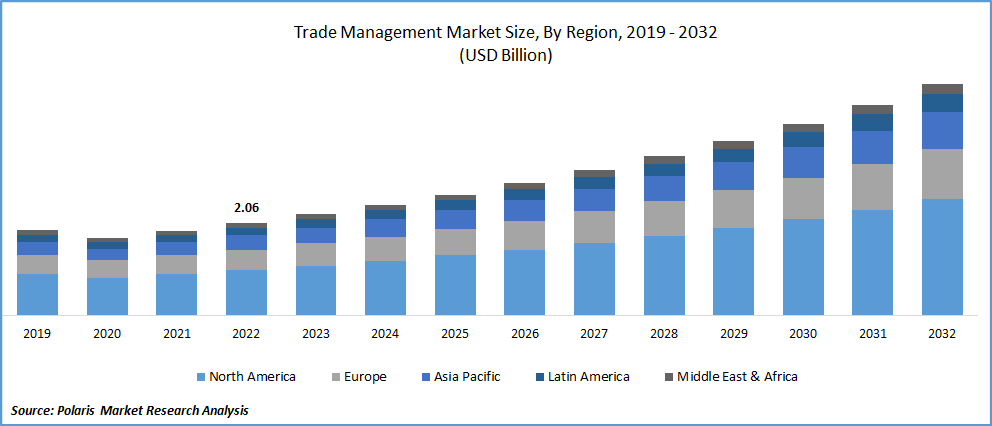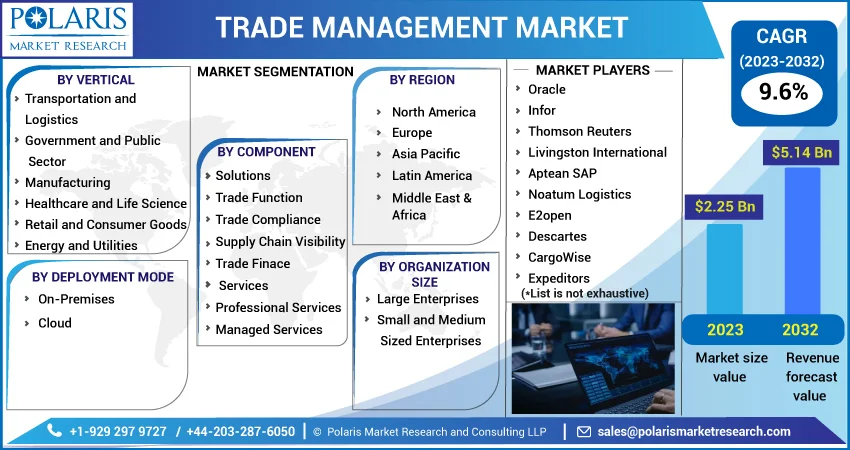
Trade Management Market Share, Size, Trends, Industry Analysis Report, By Component (Solutions and Services); By Deployment Mode; By Organization Size; By Vertical; By Region; Segment Forecast, 2023 - 2032
- Published Date:Mar-2023
- Pages: 116
- Format: PDF
- Report ID: PM3088
- Base Year: 2022
- Historical Data: 2019-2021
Report Outlook
The global trade management market was valued at USD 2.06 billion in 2022 and is expected to grow at a CAGR of 9.6% during the forecast period. The major factors driving the market growth includes an increase in globalization-related international trade activities. Additionally, the growing need for automation in trade management activities opens new prospects for the expansion of the market for trade management software. Companies may now afford to implement the new TMS platforms with about USD 8 to 10 Mn in yearly freight spending. This will create wide opportunities for the companies for the adoption of software.

Know more about this report: Request for sample pages
Market expansion is projected to be fueled by the increasing use of trade management software to automate operational import and export operations such as documentation preparation, license determination, and classification storage. According to the Deloitte Global Trade Automation Survey, automated global trade management systems are being used to streamline compliance management by 54% of respondents.
Additionally, it is anticipated that an increase in expenditures in the construction of logistical infrastructure in emerging economies will create chances for the market for trade management software to expand. In a similar vein, the report said that firms control import and export operations through global trade management systems. GTM solutions are used by 70% of businesses to manage HTS categorization storage. In addition, 40% of respondents said they use the GTM system to control Import document generation and HTS categorization determination.
The market research report offers an in-depth analysis of the industry to support informed decision-making. It offers a meticulous breakdown of various market niches and keeps readers updated on the latest industry developments. Along with trade management market on the basis of SWOT and Porter’s Five Forces models, the research report includes graphs, tables, charts, and other pictorial representations to help readers understand the key insights and important data easily.
It digitally executes a trading sequence that entails finding a set-up, figuring out allocation size, planning, and keeping track of the transaction's entry and departure points. Trade management systems are widely used in a variety of industries, including retail and consumer goods, transportation and logistics, manufacturing, aerospace and defense, and healthcare, attributable to the related convenience.

Know more about this report: Request for sample pages
Industry Dynamics
Growth Drivers
Primary forces propelling the market's expansion are the burgeoning trend of digitization and the world's fast industrialization. Market expansion is also being aided by traders' widespread adoption of software solutions to automate back-office tasks, save manual labor, and improve business operations.
Additionally, growing governmental and private investments in a variety of logistics infrastructure projects, particularly in emerging nations, for the management of import and export, are boosting market growth. In accordance with this, another reason spurring growth is due to sophisticated solutions, thereby reducing operational time and distribution costs.
Individuals can micro-manage every aspect of the supply chain network operations due to the flexible process management platforms offered by these software solutions. The implementation of supportive government policies boosting international trade operations, along with intensive research and development (R&D), are further drivers that are anticipated to fuel market growth.
Moreover, the integration of trade management services and solutions into integrated compliance and regulatory functions is contributing to the market's expansion. Furthermore, the robust performance of international commerce and the presence of well-known competitors in the industry are both serving as active growth drivers for the market for trade management. Furtherly, a great need for trade management is being created, as well as the expansion of the trade management market, due to the rising technology usage and infrastructure development in emerging nations.
Report Segmentation
The market is primarily segmented based on component, deployment mode, organization size, vertical, and region.
|
By Component |
By Deployment Mode |
By Organization Size |
By Vertical |
By Region |
|
Solutions
Services
|
|
|
|
|
Know more about this report: Request for sample pages
Services is accounted for the largest market share in 2022
Services segment garnered the largest revenue share, owing to the increase in the demand for software in the service industry. To guarantee that trade management solutions are properly integrated with the intricate network architecture installed in businesses, it is essential to have access to trade management services. By monitoring, maintaining, and upgrading the vital components of the solutions, make it easier for the solutions to continue working as intended over time. By automating & optimizing trade procedures, taking care of control expenses, lowering the likelihood of fines and penalties, and expediting customs clearance, trade management aids in accelerating the cross-border supply chain.
Cloud deployment is expected to account for the largest market share over the forecast period
Cloud segment is projected to witness higher growth rate owing to evolving awareness about cloud deployment in the people. Cloud deployment is a flexible technique to deployment that is used in the trade management industry to meet the needs of a company. One of the main advantages of cloud-based deployment is the capacity to scale up current solutions with cutting-edge technologies without incurring additional hardware and software costs.
Deployment costs are reduced because there is no requirement for on-site storage, which also decreases the systems' original cost and ongoing maintenance costs. Businesses are thinking about the cloud deployment option as a result of vendors' competitive pricing for its SaaS models & enterprises' cooperation to reach the SMEs. As an illustration, Integration Point & GT Nexus collaborated to offer businesses as a single cloud-based provider worldwide in the trade management system. More than, 190 nations offer their trade legislation to customers.
Small and medium enterprises is expected to witness fastest growth
Small and medium enterprises segment is projected to experience significant growth owing to increasing new startups as the government initiates a good environment for new businesses. The market's future is expected to be shaped by growing adoption by small and medium-sized organizations and the great potential provided by emerging economies. The market for trade management software is anticipated to grow in the next few years as a result of numerous sectors investing heavily in IT in order to keep up with the rapidly changing technological landscape.
Transportation and logistics segment is projected to witness significant growth
Transportation & logistics is projected to have a higher growth rate owing to the increasing transportation of goods and services to the other countries for the mutual benefits of trade and to get benefitted from the country's surplus, which is in a way increasing demand for software for easier operations. With rising cross border sales in the aerospace & defense, healthcare, consumer goods, & government market solutions are becoming more and more popular. The increasing difficulty businesses are having managing their intricate trade procedures is one of the key factors driving the expansion of trade management systems.
The demand in Asia Pacific is expected to witness significant growth
Asia Pacific is projected to experience higher growth owing to evolving functions of trade management in different sectors. A booming economy is forming in the Asia Pacific as a result of increased investment across a number of industries, including manufacturing, healthcare and life sciences, aerospace & defense, and transportation & logistics. By growing their exports and foreign investment, the Asia Pacific region is the main driver of growth.
Asia Pacific nations are developing nations, which is why there has been an increase in exports, this has led to an increase in GDP. As a result, many people would escape poverty and living standards would increase. Major corporations active in a variety of fields are enthusiastic about investing in and investigating new markets and opportunities in this area. As a result, it is anticipated that it would fuel the expansion of global commerce in the area and consequently open up opportunities for global trade management providers to support global market.
Competitive Insight
Some of the major players operating in the global trade management market include Oracle, Infor, Thomson Reuters, Livingston International, Aptean, SAP, Noatum Logistics, E2open, Descartes, CargoWise, Expeditors, BDP International, Accuity, QAD Precision, 3rdwave, AEB, Shipsy, Bamboo Rose, Bolero International, MIC Customs Solutions, OCR Services, Webb Fontaine, Neurored, 4PL Consultancy, Global Custom, Vigilant Global Trade Services, and Centrade.
Recent Developments
- In January 2023, Thomas Reuters Corporation completed its acquisition of SurePrep, a market leader in 1040 tax automation software and Services with the definitive agreement to buy SurePrep for USD 500 million in cash.
- In December 2022, Aptean completed acquisition of the Mishral to expand its offerings in France. This acquisition has broadened the scope of its industry-specific ERPs in France. While expanding the options Mistral can provide to its current clients, Aptean will use its worldwide scope, resources, and science and technology to speed up the adoption of Mistral's cloud-based solutions inside the equipment market.
Trade Management Market Report Scope
|
Report Attributes |
Details |
|
Market size value in 2023 |
USD 2.25 billion |
|
Revenue forecast in 2032 |
USD 5.14 billion |
|
CAGR |
9.6% from 2023 - 2032 |
|
Base year |
2021 |
|
Historical data |
2018 – 2020 |
|
Forecast period |
2023 - 2032 |
|
Quantitative units |
Revenue in USD billion and CAGR from 2023 to 2032 |
|
Segments covered |
By Component, By Deployment Mode, By Organization Size, By Vertical, By Region |
|
Regional scope |
North America, Europe, Asia Pacific, Latin America; Middle East & Africa |
|
Key companies |
Oracle, Infor, Thomson Reuters, Livingston International, Aptean, SAP, Noatum Logistics, E2open, Descartes, CargoWise, Expeditors, BDP International, Accuity, QAD Precision, 3rdwave, AEB, Shipsy, Bamboo Rose, Bolero International, MIC Customs Solutions, OCR Services, Webb Fontaine, Neurored, 4PL Consultancy, Global Custom, Vigilant Global Trade Services, and Centrade. |
We strive to offer our clients the finest in market research with the most reliable and accurate research findings. We use industry-standard methodologies to offer a comprehensive and authentic analysis of trade management market. Besides, we have stringent data-quality checks in place to enable data-driven decision-making for you.
FAQ's
The trade management market report covering key segments are component, deployment mode, organization size, vertical, and region.
The global trade management market size is expected to reach USD 5.14 billion by 2032.
The global trade management market expected to grow at a CAGR of 9.6% during the forecast period.
Asia Pacific is leading the global market.
Key driving factors in the trade management market are burgeoning trend of digitization and the world's fast industrialization.
